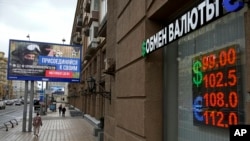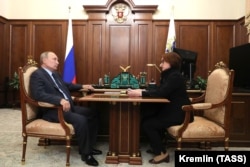When Russia’s central bank surprised economists on July 21 by hiking interest rates a full percentage point, double the expected increase, it should have buoyed the ruble -- which had been on a downward trajectory since December.
Yet the Russian currency continued to tumble against the U.S. dollar the following three weeks, breaching the important psychological level of 100 on August 14 and prompting a whopping 3.5 percentage point emergency rate hike the following day, to 12 percent.
The latest slide in the ruble comes even as Russian oil, its main source of foreign currency revenue, is fetching higher prices. Higher oil prices and a stronger ruble have often gone hand in hand, but not this time: Russia’s invasion of Ukraine has warped the country’s own economy, laying land mines for the currency.
“There is a crisis of confidence in the ruble,” Sergei Aleksashenko, a former Russian central bank chief who is now a vocal Kremlin critic, said in a tweet following the August 15 rate hike. He predicted rate increases would have little impact on the currency.
The ruble’s monthslong decline comes against the backdrop of the grinding war in Ukraine, where Russia’s forces have made few gains since the first months after the full-scale invasion in February 2022 and are facing a Ukrainian counteroffensive in both the east and south.
That fierce Ukrainian resistance is forcing Russia to ramp up military spending as Western sanctions crimp energy export revenue, creating a large budget deficit that is putting pressure on the ruble exchange rate.
Meanwhile, Russian industrial and consumer demand for imported machinery, technology, and other goods has jumped, spurring demand for dollars and euros that are harder to come by.
The ruble’s weakness is putting President Vladimir Putin in a tight spot, economists say. He needs to rein in spending if he wants to tame inflation and stabilize the ruble.
But Putin has repeatedly signaled that he intends to keep the invasion going indefinitely, and the next presidential election is coming up in March – with Putin sure to win if he runs, as expected, due to the Kremlin’s control over politics and the media. Yet, he needs to shore up his image following the brief but embarrassing mutiny by the Wagner mercenary group in June and continuing setbacks in the war.
As a result, he is unlikely to curtail military or social spending in any meaningful way, thus shifting the burden of protecting the ruble to the central bank.
“There is a tug-of-war taking place in Russia right now between President Putin’s military ambitions on the one hand and the policy objectives of the central bank and finance ministry on the other,” Liam Peach, an economist at London-based research firm Capital Economics, said in an August 15 note.
That struggle was on stark display ahead of the sharp rate hike, adding to signs of tension within the ruling elite over strains on the economy and society as the war persists.
In a column published by the state news agency TASS on August 14, Putin’s economic adviser, Maksim Oreshkin, laid into the central bank without actually naming the bank or its chief, Elvira Nabiullina, writing that “the source of the weakening of the ruble and the acceleration of inflation is soft monetary policy.”
Nabiullina, who is highly respected abroad and is credited with minimizing the damage to Russia’s economy in just over a decade as central bank chief, has pointed to the decline in foreign trade as the main cause of the ruble’s weakness and has indicated that increased state spending and labor shortages resulting from the war have fueled inflation. Experts have sided with her in the debate.
Regardless, Nabiullina’s job won’t be easy. The West has frozen an estimated $300 billion in Russian central bank foreign currency reserves, shunned investment in the country, and put a price cap on its oil exports, limiting policymakers’ ability to support the ruble, Peach said.
During periods of currency weakness prior to the full-scale invasion of Ukraine and the sanctions that followed, the central bank could sell billions of dollars in foreign currency reserves to shore up the ruble -- or Western investors, believing the currency was undervalued, could snap it up.
Peach said the risks to Russia’s economic stability are materializing faster than he anticipated. He now expects the central bank to raise the rate by another 2 percentage points before the end of the year, to 14 percent.
Higher rates crimp corporate and consumer borrowing, leading to slower inflation, and make ruble deposits a more attractive investment.
“The next few months are likely to be characterized by further falls in the ruble, and much higher inflation and interest rates,” he said.
'Normal Rules Do Not Apply'
Chris Weafer, the founder of Macro-Advisory, a consulting firm focusing on the countries of the former Soviet Union, told RFE/RL that the weak ruble is not a foreboding sign of a brewing financial crisis “because it is a managed currency in a managed economy. The normal rules do not apply.”
The ruble had been a free-floating currency prior to the February 2022 invasion. The central bank has been managing it with the help of currency controls since March 2022, when the West imposed sweeping financial sanctions on the country, Weafer said.
He said the central bank and the Finance Ministry wanted to weaken ruble following its sharp rally in 2022 in order to help narrow the budget deficit. However, “they let it slip too far” and were now being instructed “from on high” to reel it back in.
The ruble reached a seven-year high of 53 to the dollar in June 2022 as surging oil and gas prices generated a foreign currency windfall just as imports collapsed due to the Western sanctions.
The Russian budget receives more ruble tax revenue from exporters when the ruble exchange rate is lower, but a sharp drop relative to other currencies also leads to an acceleration of inflation as imports become more expensive in rubles.
The Russian currency has fallen as much as 30 percent this year and by nearly half since the June 2022 peak as oil and gas export revenue plunged and imports surged.
Weafer said the August 15 rate hike was meant to send a message that “the central bank is in control and wants the ruble to recover.”
Tatiana Orlova, an economist at Oxford Economics in Britain, told RFE/RL on August 15 that the central bank may need to resort to capital controls to stabilize the ruble. She said it could force exporters to sell their foreign currency or limit the amount of foreign currency citizens can send overseas.
'Inefficiencies' And Seasonal Factors
Putin was holding a meeting on August 16 with Finance Ministry officials to discuss imposing capital controls, the Financial Times reported.
Russians moved $43 billion into banks overseas, mainly Armenia, Georgia, and Kazakhstan, between January 2022 and May 2023, Aleksandra Prokopenko, a former adviser at the Russian central bank and now a nonresident scholar at the Berlin-based Carnegie Russia Eurasia Center, wrote in a report.
Orlova said there are other factors at play affecting the ruble, including the mismatch between the foreign currencies Russia now receives for its exports and the foreign currency it needs for imports, a new phenomenon caused by Western sanctions.
Since the West imposed energy sanctions on Russia, Moscow has had to shift more of its oil exports to Asia, including China and India.
Russia now receives rubles, Chinese yuan, and Indian rupees for some of those sales instead of dollars. But Russian companies and citizens still need dollars and euros for imports of machinery, technology, and consumer goods.
“Russian exporters end up with rupees, but no one wants them, while importers want euros or dollars,” Orlova said. “So, all these inefficiencies are contributing to the decline in the currency.”
There are also seasonal factors for the recent ruble decline as Russians buy foreign currencies ahead of their summer vacations overseas, she said, something that will soon end.
Orlova said the ruble is now undervalued following its sharp fall, assigning it a fair value of around 85 to the dollar. The ruble had strengthened to 95 to the dollar on August 16 following the rate hike and talk of capital controls.
Putin could manage to get out of the economic pickle he finds himself in if current oil prices hold or rise further, Weafer said, adding that Russia is now selling oil for more than $70 a barrel, above the Western-imposed price cap of $60.
“Unless something deteriorates, Russia’s budget will have a much better performance in the second half of the year than in the first half and the Kremlin will have enough money,” Weafer said.












